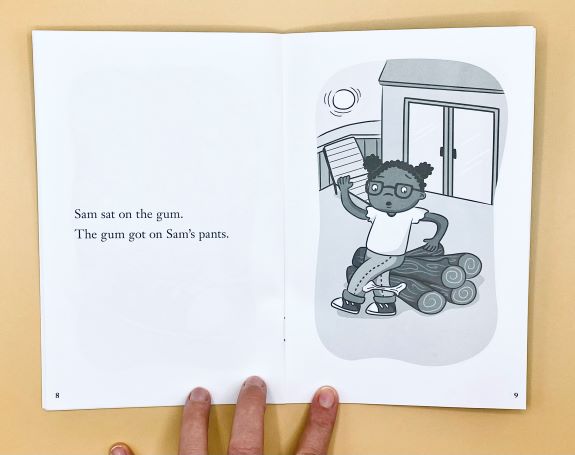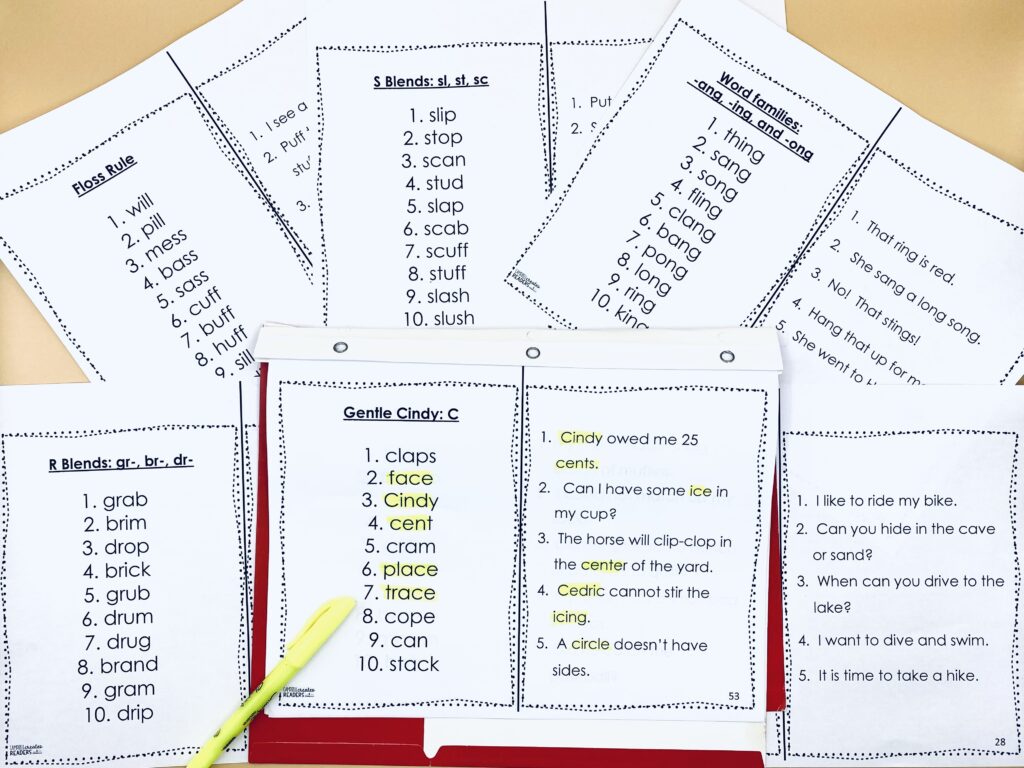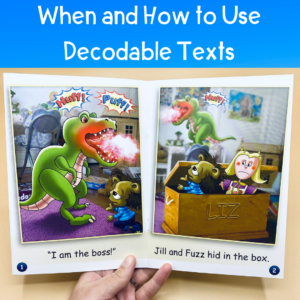
Share This:
How do we use decodable texts? Should we read them whole-group? Small group? Do we send them home with students? Do we expect children to only read decodable texts? And when do we take them away? Getting decodable texts is just the first step. After we’ve armed ourselves with the appropriate texts, what comes next? Today, I want to answer those questions.

I think it’s always important to keep purpose in mind. With decodable texts, there is a single purpose: to give children the practice they need so they can achieve automatic word recognition in the skills we’ve taught. Simply, they are there to help children learn to read words instantly. Decodables should be considered a scaffold towards our ultimate goal: fluent reading and comprehension of authentic texts.
If you are uncertain how to start incorporating decodable texts, I recommend starting in small group. Some teachers only have a few copies of a text, so you may be limited with where you can use them. Small group is a great place to start with many new techniques because teachers often have more freedom in small group, as opposed to being tied to a curriculum like most are in whole group. In small group, you can use the texts to reinforce whole group phonics skills, remediate gaps, or accelerate the learning of students.

I’m lucky to work in a school that has a large number of decodable texts, but I still find myself using printable ones (I mostly use my own word lists and sentences and Emily Gibbons’ passages). I love having printable copies of decodable texts to put into a folder. The upside to printable decodables is that you never run out of copies, and you can send them home whenever you want. You can create a decodable folder for every student in your class and use them in a whole group setting. In my school, we created decodable folders for every student, k-3. The passages in the folder are aligned to our division scope and sequence. Over the summer, administration and office staff created the folders for everyone. (Yes, my principal is amazing. No, you cannot have her.) If using folders, I suggest giving students a sticky note. I put the sticky note on our current skill and tell them that they can read/reread anything up to that point.
Ok, so we can use decodables in small group or whole group, but HOW do we use them? After you have introduced a skill, think about building from the smallest to largest unit. Before reading a decodable text, I often practice at the word and sentence level. It makes sense to give specific practice in smaller chunks before moving into larger ones. It could be as simple as putting a list of words on the board, creating a review deck, or reading word lists and sentences.
After we have practiced at the word and sentence level, it is time to move into the decodables. If students have a printable version, you can ask them to highlight in their text all the examples of specific skills (for example, highlighting all of the ai words).
From there, you have a few options for reading the text. You can echo read (highest level of support), where you read a line/sentence and then have students repeat. You can choral read, where you and the students read together. Or, you can ask students to read it on their own.

I typically do a first read of choral or echo reading, and then ask students to whisper read. As they are whisper reading, I listen in. You can do this whether they are in small group or whole group. If in whole group, you just may not get to everyone on the first read, and you may not get to listen to each child as long as you would in whole group. Once they have finished reading the text, students can either reread it or reread other passages that they have. (This is why I love decodable folders too. There’s always something to read!)
No matter where you use decodable texts, remember this: it isn’t enough to read a text once. We know that most children will orthographically map a word between 1 and 4 exposures. For some students, though, it can take hundreds of exposures to a word before they can instantly recognize it.
We cannot just say “on Tuesdays we read our decodable for the week” and expect our children to internalize the patterns. Instead, decodable reading must be a daily occurrence. Children need to read and reread decodable texts every single day. I recommend making it a part of your lesson plan so that it isn’t just left to chance. Don’t forget, you don’t have to ONLY use decodables: fluency grids, review PowerPoints, and games are all valid forms of review. Just remember that connected text should be happening as much as possible.
We do not want children to only read decodable texts. I will always support children reading whatever books they want with the adults they love. Bedtime reading and snuggled-up reading on the couch should never be prohibited. When we are reading aloud to our students in a comprehension lesson, we are not using decodable texts. Instead, we are choosing vocabulary-rich texts to build background knowledge, vocabulary, and essential understandings.
Simply, children should ALWAYS, right from the start, hear a variety of texts. But when do we expect them to start reading a variety of texts?
In my small groups, once a child has a good handle on single-syllable words and is moving into multi-syllabic words, that is when I bring in more traditional texts. I have yet to find myself going back to “leveled” texts like I used to. Once they are moving into different texts, I’m not trying to go from level m to n to o, etc. Guided reading levels aren’t normed, standardized, or particularly reliable.
Instead, I take a look at my state standards for social studies and science. I pull texts that align with those standards because I know how important it is for students to build those key understandings. If looking for fiction text, think about pulling texts that can build on specific themes, like perseverance or loyalty.
I hope I’ve helped put your mind at ease about ways to use decodable texts. I don’t think I had ever even heard the phrase decodable text in my teacher preparation program, so I know how overwhelming it can be to get started. So remember that decodable texts are there to help achieve instant word recognition, they can be used wherever, and they are a scaffold for our students.
Did you love the book on my cover image? Me too! It’s from Phonic Books, and its called Rex Yells. It’s from the Dandelion Launchers series! Check it out!

Share This:

Savannah Campbell is a K-5 reading specialist. She has taught her entire 12-year teaching career at the school she went to as a child. She holds two master’s degrees in education from the College of William and Mary. Savannah is both Orton-Gillingham and LETRS trained. Her greatest hope in life is to allow all children to live the life they want by helping them to become literate individuals.

Savannah Campbell is a K-5 reading specialist. She has taught her entire 12-year teaching career at the school she went to as a child. She holds two master’s degrees in education from the College of William and Mary. Savannah is both Orton-Gillingham and LETRS trained. Her greatest hope in life is to allow all children to live the life they want by helping them to become literate individuals.
Feeling overwhelmed with all the terminology out there? Want to know the key terms all teachers need to teach phonics? In this FREE Rules of English cheat sheet, you get a 5 page pdf that takes you through the most important terms for understanding English—you’ll learn about digraphs, blends, syllable types, syllable divisions, and move. Grab today and take the stress out of your phonics prep!
